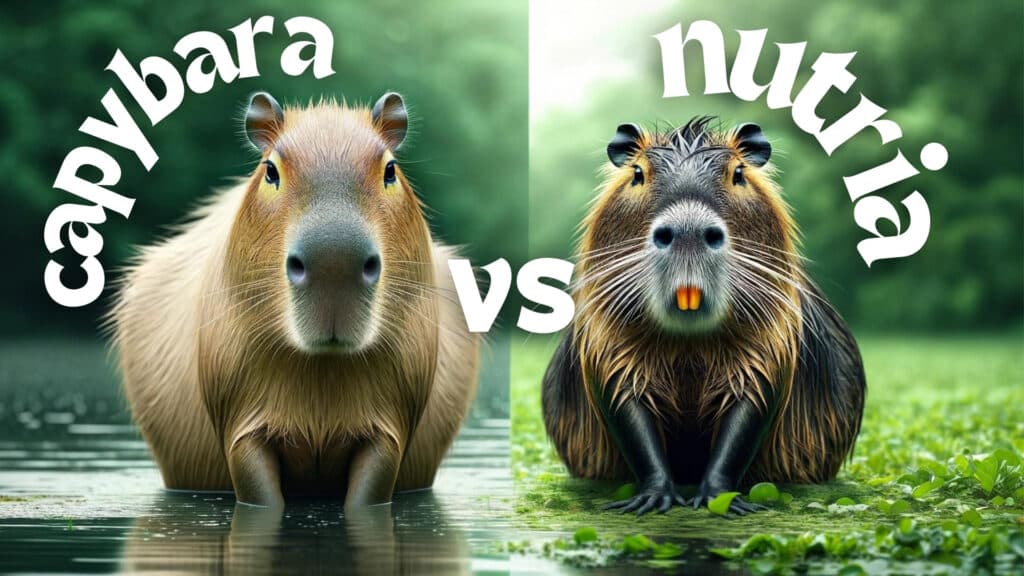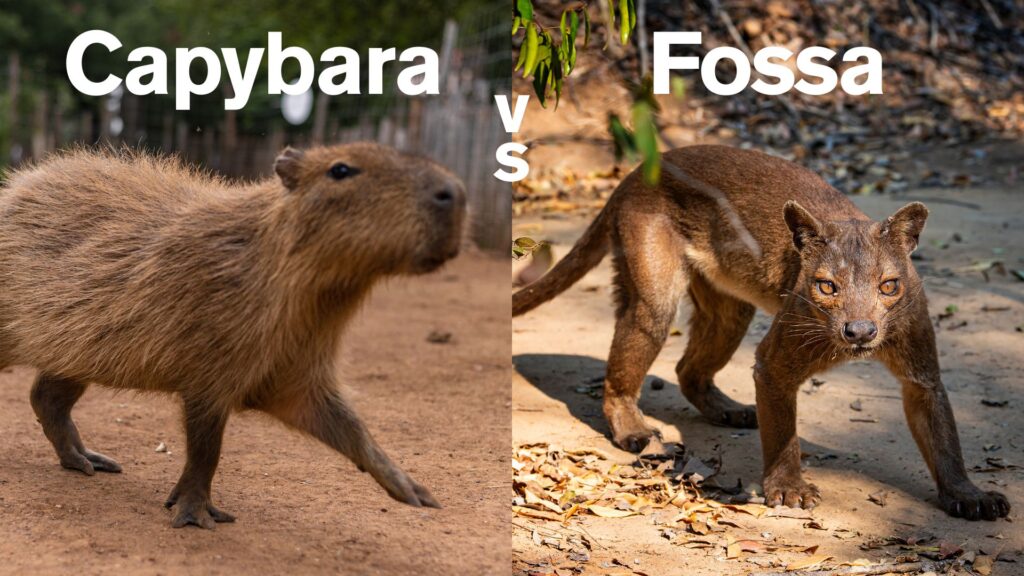The fundamental differences between capybaras and wombats extend far beyond their geographical origins. Capybaras are semi-aquatic and depend on freshwater habitats, while wombats are terrestrial burrowers that thrive in diverse Australian landscapes. This core distinction shapes every aspect of their lives.
Main Key Differences
Capybaras belong to the rodent family and hold the impressive title of being the world’s largest rodent. Their bodies are perfectly designed for a semi-aquatic lifestyle, complete with webbed feet for swimming and eyes positioned on top of their heads to stay alert while partially submerged. In contrast, Wombats are marsupials with powerful claws and muscular builds designed for extensive digging and underground living.
The size difference is also notable. Capybaras are larger and have webbed feet for swimming, while wombats are smaller, stockier, and equipped with powerful claws and a tough hide for digging and defence. These physical adaptations reflect their completely different survival strategies and environmental needs.
Beyond wombats, some readers also compare capybaras with mountain-dwelling marmots, which show very different lifestyles and social behaviors.
Comparative Species Information
| Characteristic | Capybara | Wombat |
|---|---|---|
| Kingdom | Animalia | Animalia |
| Class | Mammalia | Mammalia |
| Order | Rodentia | Diprotodontia |
| Phylum | Chordata | Chordata |
| Grooming | Social grooming in groups | Self-grooming, solitary |
| Genus | Hydrochoerus | Lasiorhinus/Vombatus |
| Species | H. hydrochaeris | L. krefftii (Hairy-nosed) |
| Family | Caviidae | Vombatidae |
| Life Expectancy | 8-10 years (wild), 12 years (captivity) | 15 years (wild), 20 years (captivity) |
| Hunting Ability | None (herbivore) | None (herbivore) |
| Loneliness | Cannot tolerate isolation | Thrives in solitude |
| Space | Requires large territories near water | Requires extensive burrow systems |
| Affection | Highly affectionate, social bonding | Limited affection, mostly solitary |
| Protection | Group protection, water escape | Burrow systems, tough hide defense |
| Energy | Moderate to high activity | Low energy, slow metabolism |
| Weight | 35-66 kg (77-146 pounds) | 20-35 kg (44-77 pounds) |
| Height/Size | Up to 1.3 meters (4 feet) length | About 1 meter (3.3 feet) length |
| Physical Characteristics | Webbed feet, water-adapted eyes/ears/nostrils | Powerful claws, tough rear hide, muscular build |
Behavior
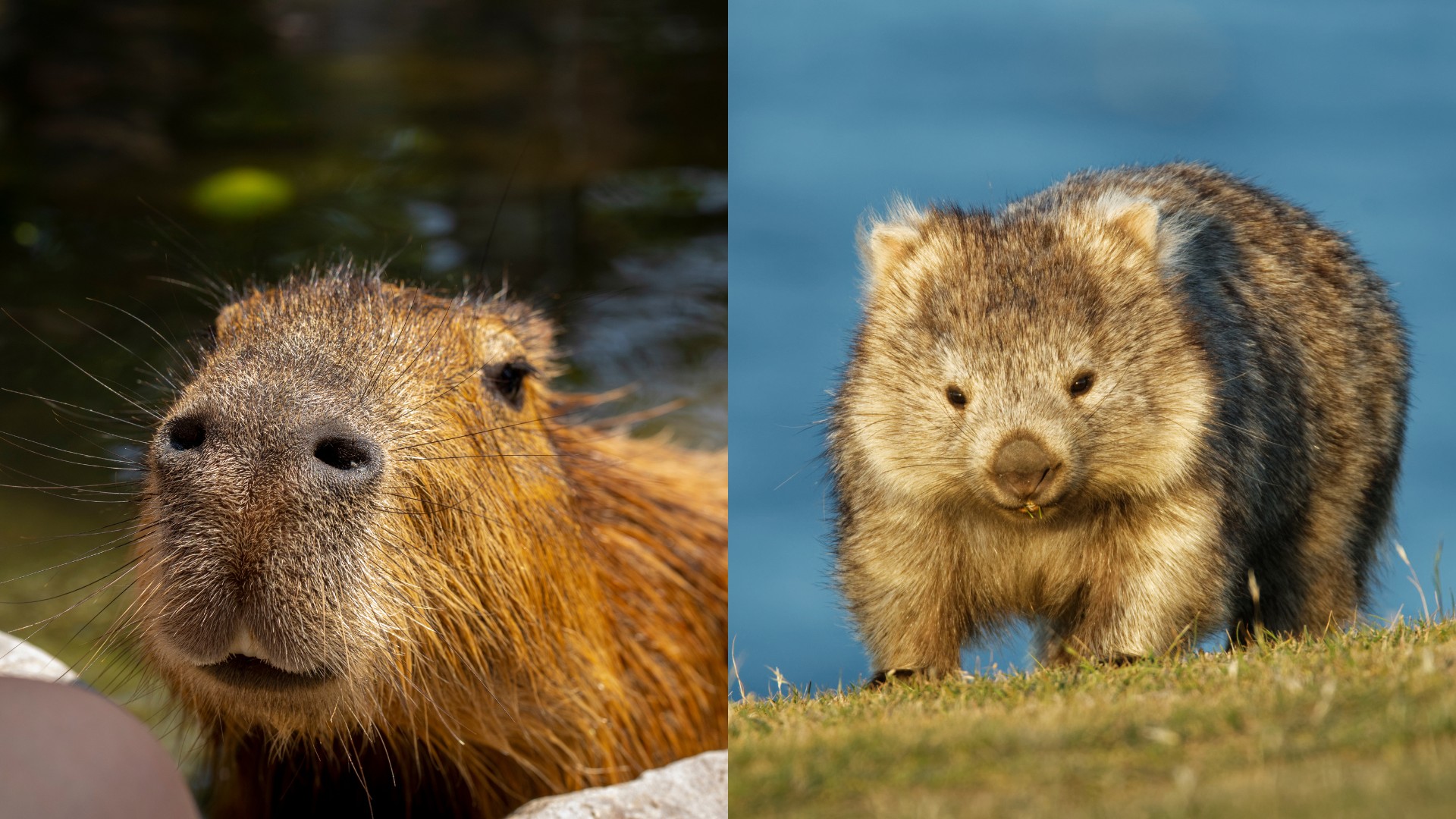
The behavioral differences between these two species are striking and reflect their distinct evolutionary paths. Capybaras are highly social animals that live in groups ranging from 10 to 20 individuals. During dry seasons, these groups can expand dramatically, sometimes including up to 100 individuals gathering around scarce water sources.
Capybaras demonstrate remarkable social cooperation that extends beyond their own species. They’re frequently observed sharing space peacefully with birds, turtles, monkeys, and other wildlife. This friendly nature has earned them a reputation as one of the most sociable animals in the animal kingdom.
Wombats, however, follow a completely different social strategy. They are primarily solitary creatures who prefer the independence of underground burrow systems. While they occasionally share overlapping burrow networks with other wombats, these interactions are generally peaceful but limited. Wombats are also nocturnal, while capybaras don’t sleep very much at all.
Communication styles also differ significantly. Capybaras are quite vocal, using barks, whistles, purrs, and grunts to maintain group cohesion and warn of dangers. Wombats, conversely, are relatively silent, relying more on scent marking and physical gestures to communicate with their environment and occasional neighbors.
Personality

The personality differences between capybaras and wombats are as distinct as their physical appearances.
Capybaras exhibit what can only be described as a zen-like calmness. Their peaceful demeanor and apparent lack of aggression toward other species has made them internet celebrities and beloved zoo animals worldwide. They seem to approach life with a relaxed attitude that’s both endearing and remarkable.
This calm personality isn’t just for show it serves important survival functions. Their peaceful nature allows them to form beneficial relationships with other species, creating a network of mutual lookouts for predators. When danger approaches, these diverse groups can provide early warning systems that benefit everyone involved.
Wombats display a more reserved and cautious personality. While not aggressive by nature, they’re more territorial and protective of their space. Their personality reflects their solitary lifestyle they’re self-reliant, determined, and incredibly focused when it comes to their primary activities of digging and foraging. When threatened, wombats can become surprisingly fierce defenders of their territory.
While wombats share a land-based lifestyle with capybaras, things get more unpredictable when capybaras interact with surprising species like pelicans.
Intelligence
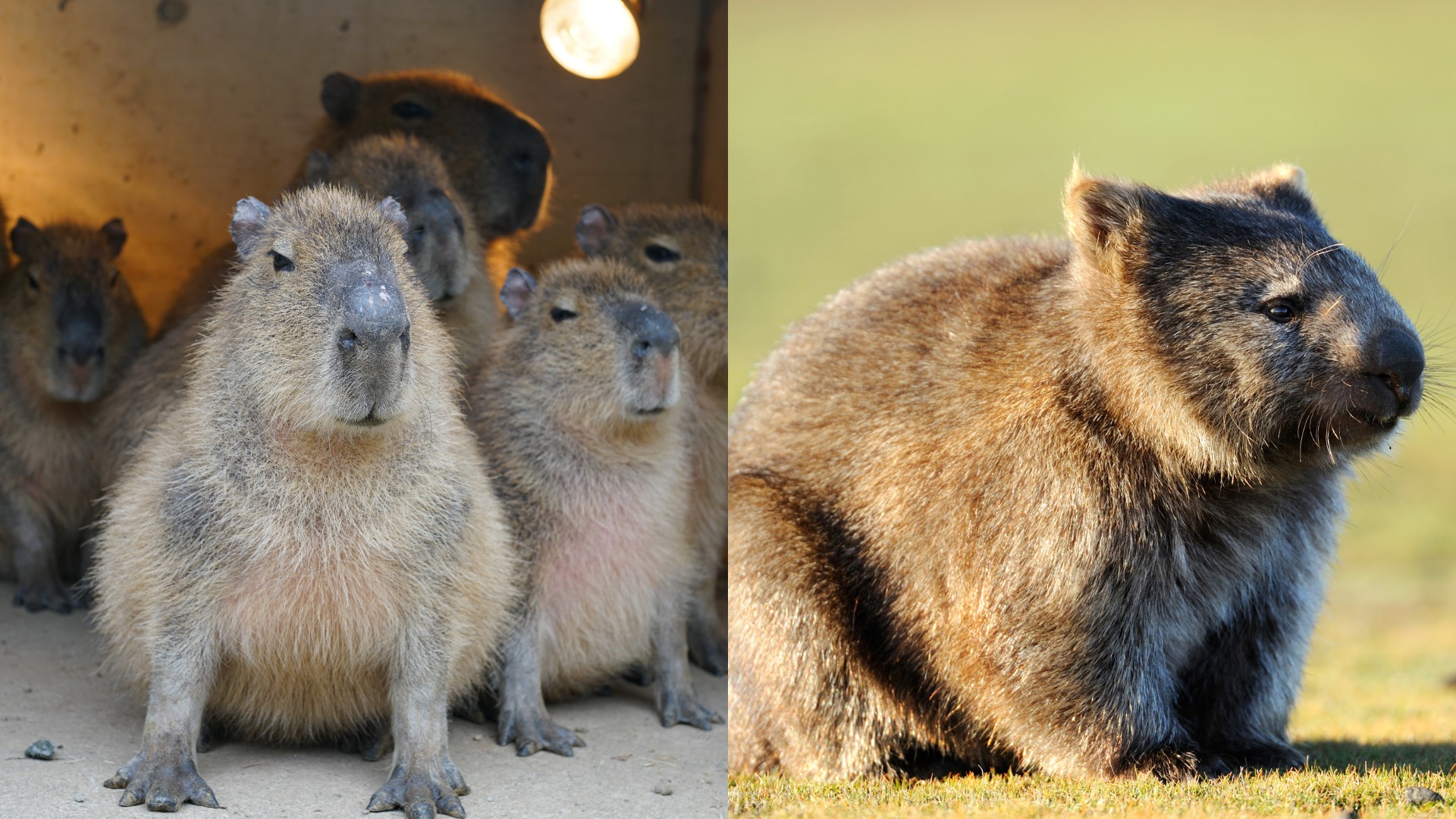
Both species demonstrate intelligence adapted to their specific environmental challenges, though they express it in different ways. Capybaras show social intelligence through their complex group dynamics and communication systems. They can recognize individual group members, maintain hierarchical relationships, and coordinate group movements effectively. Their ability to form peaceful relationships with diverse species also suggests a form of emotional intelligence that’s quite remarkable.
Capybaras also demonstrate problem-solving abilities related to their aquatic lifestyle. They can assess water conditions, judge safe distances from shore, and make split-second decisions about when to dive to escape predators. Their ability to remain calm under pressure while making these critical decisions speaks to their cognitive abilities.
Wombats display intelligence through their engineering skills. The complex burrow systems they create require spatial reasoning, planning, and architectural understanding. These underground networks can extend up to 30 meters in length and include multiple chambers, entrances, and even nursery areas. The precision and complexity of these structures demonstrate sophisticated problem-solving abilities.
Their intelligence also shows in their resource management. Wombats must carefully balance energy expenditure with food intake, given their slow metabolism. They’ve learned to optimize their foraging routes and timing to maximize nutrition while minimizing energy waste.
Swimming Power

This category clearly favors the capybara, whose entire lifestyle revolves around aquatic environments.
Capybaras can swim at a speed of up to 5 miles per hour (or 8 kmh), making them remarkably fast in water. Their webbed feet act like natural paddles, while their streamlined bodies cut through water with surprising efficiency.
Perhaps most impressively, capybaras can remain underwater for up to five minutes when avoiding predators. This ability, combined with their swimming speed, makes water their primary escape route from land-based threats. Unlike comparing capybaras with beavers, which are both semi-aquatic but have different swimming techniques, capybaras rely purely on speed and stealth underwater. Their eyes, ears, and nostrils positioned on top of their heads allow them to swim with most of their body submerged while maintaining awareness of their surroundings.
Wombats, on the other hand, are not built for aquatic life. The capybara is a prolific swimmer, as we have already discussed, while a wombat avoids swimming if at all possible. Their dense, muscular bodies and short legs make swimming difficult and energy-intensive. When wombats encounter water, they generally seek alternative routes rather than attempting to swim across.
Running Speed
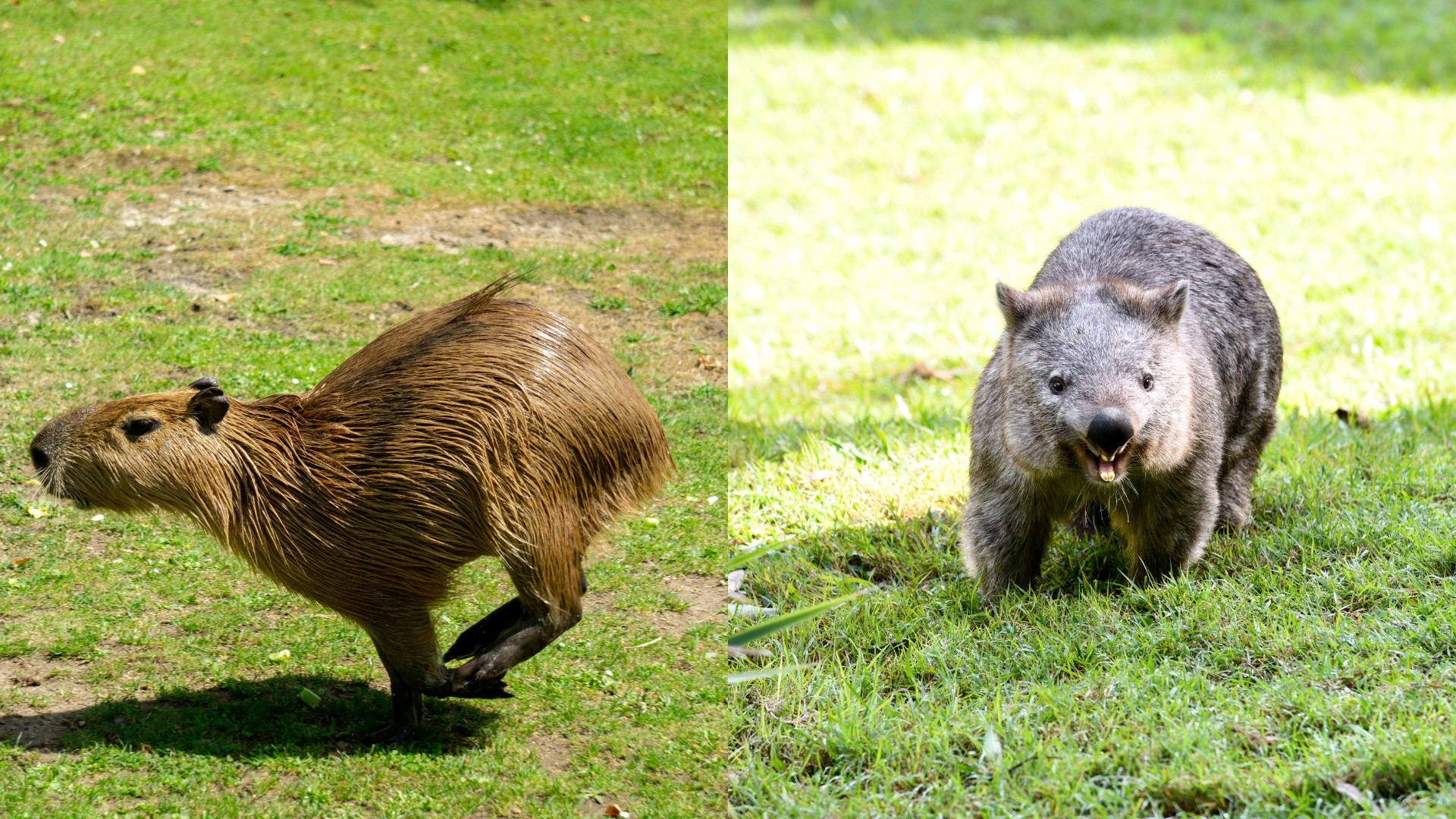
While capybaras excel in water, both species are capable of impressive land speeds when necessary.
Capybaras are capable of reaching speeds of up to 35 kilometers an hour—that’s as fast as a horse! This speed serves them well when they need to reach water quickly to escape predators.
Wombats, despite their chunky appearance, can reach speeds of up to 25 mph (40 km/h) according to comparative data. This speed is particularly impressive given their body structure and demonstrates the power of their muscular build. However, wombats typically rely more on their defensive capabilities and burrow systems than on outrunning threats.
The difference in running strategies reflects their respective survival approaches: capybaras run to reach water safety, while wombats typically run to reach their burrow systems where they can use their defensive advantages.
Body Language
Capybaras communicate extensively through body language, reflecting their highly social nature. They use various postures to indicate dominance, submission, alertness, and relaxation. A relaxed capybara will often lie partially submerged in water or stretch out in sunny spots. Alert capybaras lift their heads high and position their ears forward, while submissive individuals will lower their heads and avoid direct eye contact with dominant group members.
During social grooming sessions, capybaras display trust and bonding through relaxed postures and gentle movements. Their peaceful body language extends to interactions with other species, often remaining calm and still when birds perch on them or other animals approach.
Wombats use more subtle body language, primarily focused on territorial communication. They mark their territory through scent and physical signs rather than elaborate displays. When threatened, a wombat’s body language becomes defensive—they lower their center of gravity, position themselves to protect their burrow entrance, and prepare to use their tough rear hide as a shield.
A relaxed wombat moves with a distinctive waddle, while an alert wombat becomes more rigid and focused. Their body language is generally more reserved and practical, reflecting their solitary nature and focus on individual survival rather than group coordination.
Capybaras have a surprisingly calm nature, but their interactions with predators offer another angle—see how they stack up in this comparison with the agile and carnivorous fossa.
Habitat and Geographic Distribution
The geographic separation of these species has led to their dramatically different adaptations.
Capybaras are exclusively found in South America, thriving in regions with abundant water sources including rivers, lakes, wetlands, and swamps. They require tropical and subtropical climates with consistent access to freshwater for cooling, drinking, and escape from predators.
These semi-aquatic mammals have adapted to live in diverse South American ecosystems, from Amazon rainforests to Venezuelan llanos and Argentine wetlands. Human agricultural development has actually created new habitats for capybaras in some areas, as they readily adapt to farm ponds and irrigation systems.
Wombats are found only in Australia, where they’ve adapted to an impressive range of environments. From eucalyptus forests to open grasslands and mountainous regions, wombats have proven remarkably adaptable to different Australian landscapes. Some species, like the common wombat, prefer temperate forest environments, while others, such as the southern hairy-nosed wombat, thrive in more arid conditions.
The burrow systems that wombats create are marvels of natural engineering, often extending 30 meters in length with multiple entrances and chambers. These underground networks provide protection from Australia’s extreme weather conditions and serve as nurseries for young wombats.
Diet and Digestive Adaptations
Both species are strict herbivores, but their digestive strategies reflect their different environments and lifestyles. Capybaras have developed a unique digestive system that includes coprophagy—the practice of eating their own feces to extract maximum nutrition from their plant-based diet. This adaptation allows them to re-digest food and absorb nutrients that weren’t processed during the first pass through their digestive system.
Capybaras primarily consume grasses, aquatic plants, fruits, and vegetables. Their diet is closely tied to water-based vegetation, which they can access easily due to their semi-aquatic lifestyle. They use their continuously growing teeth to process tough, fibrous plant material through hindgut fermentation. When examining capybaras and nutria, both species share similar aquatic feeding habits, though capybaras have more diverse dietary preferences and better social coordination while foraging.
Wombats have adapted to survive on much lower-quality vegetation through an extremely slow metabolism and highly efficient digestive system. They can extract maximum nutrition from grasses, roots, bark, and other tough plant materials that many animals couldn’t digest effectively. Their digestion process can take several days, allowing them to extract every possible nutrient from their food.
This digestive efficiency is crucial for wombats living in arid environments where high-quality food sources are scarce. They can consume up to 8 percent of their body weight in vegetation during a single night of foraging, then slowly extract nutrients over the following days.
Conservation Status and Threats
Both species face conservation challenges, though for different reasons. Capybaras are generally stable in most of their range, but face pressure from habitat destruction, hunting for meat and hides, and human encroachment on wetland habitats. Climate change poses additional threats as it affects water availability in their preferred habitats.
Wombats face more serious conservation concerns. The northern hairy-nosed wombat is critically endangered, with fewer than 200 individuals remaining in the wild, making it one of the world’s rarest mammals. Common wombats face threats from vehicle collisions, habitat destruction, and competition with livestock for food resources.
Conservation efforts for both species focus on habitat protection and human-wildlife conflict mitigation. For capybaras, this includes protecting wetland ecosystems and managing human-capybara interactions in agricultural areas. For wombats, conservation efforts include road safety measures, habitat restoration, and careful management of the critically endangered populations.
Conclusion
The comparison between capybaras and wombats reveals two remarkable examples of how different evolutionary paths can lead to success in completely different environments. While capybaras have mastered the art of semi-aquatic social living in South America’s wetlands, wombats have perfected the solitary, underground lifestyle in Australia’s diverse landscapes.
Each species represents a unique solution to survival challenges. Capybaras demonstrate the power of social cooperation, aquatic adaptation, and peaceful coexistence with other species. Wombats showcase the effectiveness of individual resourcefulness, engineering prowess, and defensive specialization.
Whether you’re drawn to the capybara’s zen-like social nature or the wombat’s impressive engineering abilities, both animals offer fascinating insights into the diversity of mammalian life. Their different approaches to similar challenges—finding food, avoiding predators, and raising young—highlight the incredible adaptability of life on Earth. For readers interested in exploring more rodent comparisons, learning about capybaras and guinea pigs reveals how size and habitat differences have shaped these related species in fascinating ways.
Understanding these differences not only satisfies our curiosity about the natural world but also emphasizes the importance of protecting the diverse habitats that allow such unique creatures to thrive. From South America’s wetlands to Australia’s varied landscapes, preserving these environments ensures that future generations can continue to marvel at the remarkable adaptations of capybaras and wombats.

